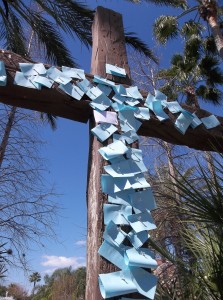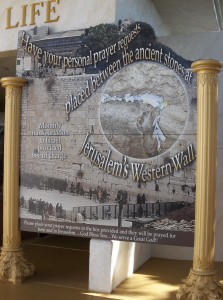 In Orlando, Florida people pin prayers to a cross. The cross stands on the grounds of the Holy Land Experience (HLE), a fifteen-acre “living, biblical museum” that teaches Christian themes in a themed environment eleven miles northeast of the Walt Disney World Resort. HLE is a site on the American religious landscape where materiality flourishes: religious history and textual ideologies are re-presented in a way that fuses evangelical commitments with the logics of immersive entertainment.
In Orlando, Florida people pin prayers to a cross. The cross stands on the grounds of the Holy Land Experience (HLE), a fifteen-acre “living, biblical museum” that teaches Christian themes in a themed environment eleven miles northeast of the Walt Disney World Resort. HLE is a site on the American religious landscape where materiality flourishes: religious history and textual ideologies are re-presented in a way that fuses evangelical commitments with the logics of immersive entertainment.
HLE’s “Testimony Cross Garden” exemplifies this site’s ongoing effort to document the many diverse ways in which pray-ers pray and prayers are prayed. We can observe much in the way of constitutive material acts. We might begin with the writing itself. Like keeping a daily prayer journal or submitting a prayer card to Oral Roberts, a power is harnessed by putting pen to paper, externalizing human interiors. (This extends the associations between writing technologies and faith emphasized by other Christian performances, as when one sings the opening lines of the Gospel standard When God Dips His Love in My Heart: “When God dips His pen of love in my heart and writes my soul a message He wants me to know…”) Then there is the folding. Each prayer is bent; some loose and uneven, some tight and perfectly aligned. Folding eases a tension between the public quality of the cross and the secrecy of each paper’s contents (“this is just between me and God”). Once folded, there is the pinning, attaching, affixing; full of iconicity. The park map that each guest receives when entering prompts us to “nail your burdens (prayer requests) to the cross.” And, there are numerous bodily tactics at work: taking the paper, holding the pen, reaching up, kneeling down, stretching left or right, touching the cross.
 We might also observe the visual achievements of the pinned prayers. Pray-ers choose from four colored square sheets: blue = “PRAYER REQUEST,” white = “SALVATION REPORT,” pink = “PRAISE REPORT,” and yellow = “REDEDICATION REPORT.” One imagines that, from one day to the next, the rainbow effect varies, telling a story about the human interiors that are present on that particular day. Notice, too, that these pray-ers color inside the lines, one-by-one forming a layer of prayers atop the wooden cross.
We might also observe the visual achievements of the pinned prayers. Pray-ers choose from four colored square sheets: blue = “PRAYER REQUEST,” white = “SALVATION REPORT,” pink = “PRAISE REPORT,” and yellow = “REDEDICATION REPORT.” One imagines that, from one day to the next, the rainbow effect varies, telling a story about the human interiors that are present on that particular day. Notice, too, that these pray-ers color inside the lines, one-by-one forming a layer of prayers atop the wooden cross.
As vital as these material and bodily acts, dimensions, and technologies are, I offer this example with a slight recalibration in mind. Here, the materiality of prayer is also about transforming a prayer into a thing: a small piece of writing. What happens when prayers become things? One answer to this question is suggested by a sign that stands a short walk from the Testimony Cross Garden.
 When these prayers become small pieces of writing they become something that travels easily. Small pieces of writing can be gathered, packed together, given “transportation” (note: not “mailed” or “sent”), and “placed between the ancient stones.” Of course, the destination of these traveling prayers is not incidental. Jerusalem’s “Western Wall” is a featured site for Protestant pilgrims to the Holy Land. Christian claims to the Wall, such as inserting written prayers into its fissures, also participate symbolically in the ongoing contest over biblical land, as the Wall is also valued and sought by praying Jews and Muslims. Making prayer into a thing is, in part, a matter of efficacy. The power of your request or report is intensified when you write it out on a small square of colored paper; its intensification furthers when pinned to the cross; and, the prayer intensifies again when it travels to a crevice in the Western Wall.
When these prayers become small pieces of writing they become something that travels easily. Small pieces of writing can be gathered, packed together, given “transportation” (note: not “mailed” or “sent”), and “placed between the ancient stones.” Of course, the destination of these traveling prayers is not incidental. Jerusalem’s “Western Wall” is a featured site for Protestant pilgrims to the Holy Land. Christian claims to the Wall, such as inserting written prayers into its fissures, also participate symbolically in the ongoing contest over biblical land, as the Wall is also valued and sought by praying Jews and Muslims. Making prayer into a thing is, in part, a matter of efficacy. The power of your request or report is intensified when you write it out on a small square of colored paper; its intensification furthers when pinned to the cross; and, the prayer intensifies again when it travels to a crevice in the Western Wall.
As these prayers become things, they also help forge a link between two places: a “living, biblical museum” in Florida and the Holy Land sites that inspire Orlando’s materialized re-presentations. The organizing conceit of HLE is the same as the one that led to the building of Palestine Park near Chautauqua Lake in 1874: while the sacred lands written of in scripture cannot be directly experienced by many Americans, their power can still be felt and remembered through material acts of re-creation. Here, producing prayer as a thing is part of producing sacred memory.
Tracking what happens when prayers become things is an ethnographic achievement that becomes possible when we work “against [the] foundational narrative of prayer as a history of abstraction.” In the case of written prayers at the Holy Land Experience, the stakes of efficacy and sacrality become visible. If small pieces of writing on thin paper can do this much, what might the more elaborate versions of prayers-as-things do?
Tags: efficacy, Evangelicalism, memory, place, writing

